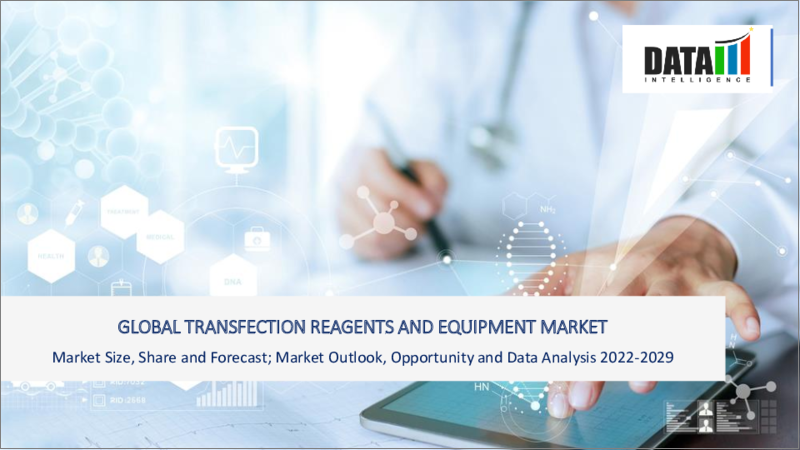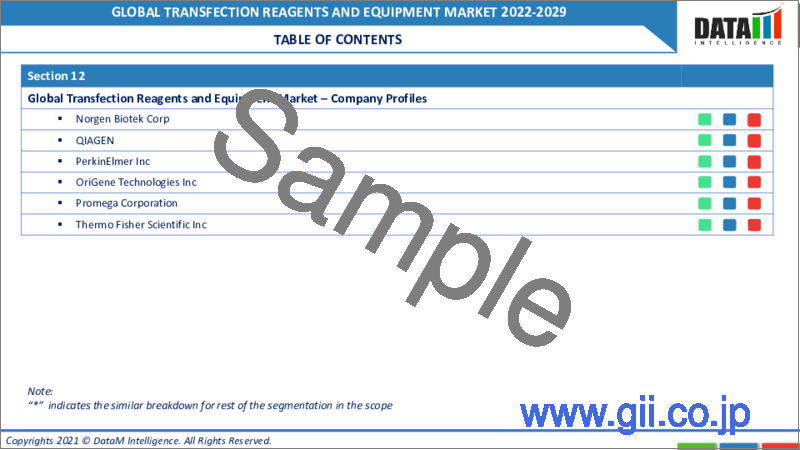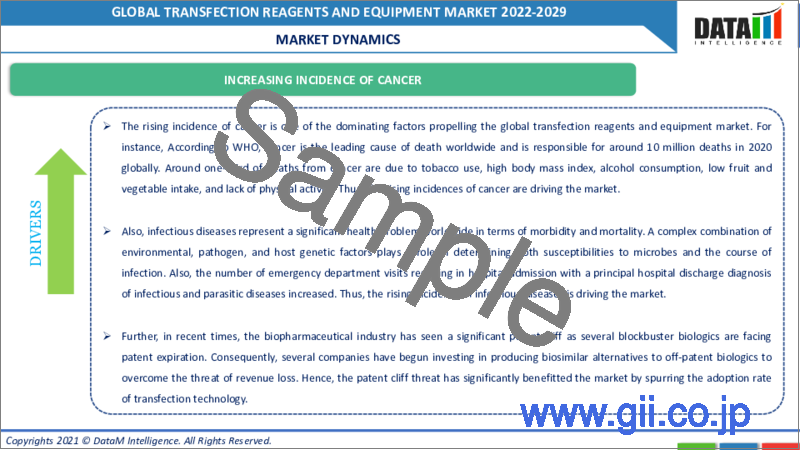|
|
市場調査レポート
商品コード
1140752
トランスフェクション試薬・機器の世界市場-2022-2029Global Transfection Reagents and Equipment Market - 2022-2029 |
||||||
|
● お客様のご希望に応じて、既存データの加工や未掲載情報(例:国別セグメント)の追加などの対応が可能です。 詳細はお問い合わせください。 |
|||||||
| トランスフェクション試薬・機器の世界市場-2022-2029 |
|
出版日: 2022年10月20日
発行: DataM Intelligence
ページ情報: 英文 170 Pages
納期: 約2営業日
|
- 全表示
- 概要
- 目次
市場力学
癌の発生率の増加が市場成長の原動力
癌の発生率の上昇は、世界のトランスフェクション試薬・機器市場を推進する支配的な要因の1つです。例えば、WHOによると、がんは世界の主要な死因であり、2020年に世界で約1000万人が死亡する原因となっています。がんによる死亡の約3分の1は、タバコの使用、高体重指数、アルコール摂取、果物や野菜の摂取量の少なさ、運動不足が原因となっています。したがって、がんの発生率の増加が市場を牽引しています。
また、感染症は、罹患率および死亡率の点で、世界的に重大な健康問題になっています。感染症は、環境因子、病原体因子、宿主の遺伝的因子が複雑に絡み合い、微生物に対する感受性と感染経過の両方を決定する役割を担っています。また、救急外来を受診して入院し、退院時の主な診断名が感染症や寄生虫症であるケースも増えています。このように、感染症の発生件数は増加傾向にあり、市場を牽引しています。
さらに、最近のバイオ医薬品業界では、いくつかの大ヒット生物製剤が特許満了を迎えているため、特許の崖が顕著になっています。その結果、いくつかの企業は収益低下の脅威を克服するために、特許切れ生物製剤の代替となるバイオシミラー医薬品の製造に投資し始めています。したがって、特許切れの脅威は、トランスフェクション技術の採用率に拍車をかけ、市場に大きな利益をもたらしています。
しかし、トランスフェクション試薬・機器の高コスト、試薬挿入時のリスク要因、トランスフェクション試薬の選択的有効性と一定の限界、トランスフェクション技術に伴う細胞毒性は、トランスフェクション試薬・機器市場を抑制する主要因となっています。
また、ウイルスベクターをゲノムにランダムに組み込むため、効果的にトランスフェクションできる細胞の数が限られること、臨床や実験室での使用が制限され、重大なバイオハザード・リスクが生じることも、トランスフェクション試薬が提供する制約の一部となっています。
地理的浸透。
予測期間中、北米が主要な地域となっています。
北米は、さまざまながんの発生率の上昇、プロテオミクスおよびゲノミクス技術に対する需要の増加、予防医療に関する政府の積極的な取り組みなどにより、トランスフェクション試薬・機器市場の世界の支配的な地位を占めています。癌の発生率の上昇は、市場を押し上げると予想されます。例えば、2021年には、米国で新たに1,898,160人のがん患者が発生し、608,570人ががんによる死亡を経験するとされています。このように、がん患者数の増加が市場を牽引しています。予防ヘルスケアに関連する政府による先行的なイニシアティブの存在は、市場を後押しすると予想されます。例えば、米国癌協会は、より良い治療法の発見、癌を引き起こす要因の解明、癌患者のQOL向上のために、癌研究に48億米ドル以上を投資しています。また、米国国立がん研究所は、がんの予防、原因、診断、治療、がんからの回復、がん患者の継続的なケアに関する研究、健康情報の普及、その他のプログラムを実施・支援する「国立がんプログラム」を取りまとめました。このように、予防医療に対する政府の取り組みが市場を牽引しています。全米科学財団(NSF)のような資金調達や連邦政府機関は、バイオテクノロジー部門に、バイオテクノロジーに基づく調査研究を実施するための莫大な資金を提供しています。さらに、NIHや調査トラストのような国際的な資金提供機関は、遺伝子研究調査のための資金を提供することで、市場成長に重要な役割を果たすと期待されています。
競合情勢。
世界のトランスフェクション試薬・機器市場で事業を展開している主要企業は、Bio-Rad Laboratories, Inc、Merck KGaA、Agilent Technologies、Illumina, Inc、Norgen Biotek Corp、QIAGEN、PerkinElmer Inc、OriGene Technologies Inc、Promega Corporation、Thermo Fisher Scientific Inc.です。一部の主要なキープレイヤーは、ビジネスを拡大するために合併やコラボレーション戦略に従っています。例えば、2022年5月、アジレントはAPCとのリアルタイム・プロセス・モニタリングに関する協業を発表しました。この買収により、両社は技術を組み合わせ、液体クロマトグラフィーを介した自動プロセス分析をサポートする独自のワークフローを顧客に提供します。この協業により、お客様へのサービスや技術が強化されます。2022年2月、アジレントは、ラボ試験における革新的な分析ソリューションを創出するAIおよび機械学習ソフトウェア開発企業であるVirtual Control社が開発した先進の人工知能(AI)技術を買収しました。この買収は、ラボの生産性を向上させるためのデジタル技術への投資です。2021年8月、DNAシーケンスの世界リーダーであるイルミナは、「Accelerate Patient Access to Life-Saving Multi-Cancer Early-Detection tests」のため、複数のがんの早期発見に注力するヘルスケア企業であるGRAILを買収しました。2022年8月、メルクは、韓国に拠点を置き、半導体のヒーターブロックとケミカルプレカーサーを製造する上場企業であるMecaro社の化学事業を買収しました。この買収により、メルクはエレクトロニクス事業を拡大し、地域的な能力と世界の能力をさらに向上させます。この買収には、30億ユーロ以上の投資が含まれています。
世界のトランスフェクション試薬・機器市場に関するレポートでは、約61の市場データ表、51の図、170ページへのアクセスを提供します。
目次
第1章 調査手法と調査範囲
- 調査手法
- 調査目的および調査範囲
第2章 市場の定義と概要
第3章 エグゼクティブサマリー
- 製品タイプ別市場内訳
- アプリケーション別市場内訳
- エンドユーザー別市場内訳
第4章 ダイナミクス
- 市場影響要因
- 促進要因
- 癌の発生率の増加
- トランスフェクションの技術的進歩
- 抑制要因
- トランスフェクション試薬の限界
- ビジネスチャンス
- 影響分析
- 促進要因
第5章 産業分析
- ポーターのファイブフォース分析
- 規制分析
- サプライチェーン分析
- プライシング分析
- アンメットニーズ分析
第6章 製品タイプ別分析
- 試薬
- 脂質媒介トランスフェクション
- DEAE-デキストラン
- リン酸カルシウム
- 活性化デンドリマー
- カチオンポリマー
- その他
- 装置
- リポソーム
- エレクトロポレーション
- マイクロインジェクション
- レーザーフェクション
- その他
第7章 アプリケーション別
- バイオメディカルリサーチ
- がん研究
- 遺伝子発現
- トランスジェニックモデル
- タンパク質生産
- 治療薬デリバリー
第8章 エンドユーザー別
- 製薬会社、バイオテクノロジー企業
- 研究機関
- その他
第9章 地域別
- 北米
- 米国
- カナダ
- メキシコ
- 欧州
- ドイツ
- 英国
- フランス
- イタリア
- スペイン
- その他欧州
- 南米
- ブラジル
- アルゼンチン
- その他の南米地域
- アジア太平洋地域
- 中国
- インド
- 日本
- オーストラリア
- その他アジア太平洋地域
- 中東・アフリカ地域
第10章 競合情勢
- 競合シナリオ
- 市況ポジショニング/シェア分析
- M&A(合併・買収)分析
第11章 企業プロファイル
- Bio-Rad Laboratories, Inc.
- 企業概要
- 製品ポートフォリオと説明
- 主なハイライト
- 財務概要
- Merck KGaA
- Agilent Technologies
- Illumina, Inc.
- Norgen Biotek Corp.
- QIAGEN
- PerkinElmer Inc.
- OriGene Technologies Inc.
- Promega Corporation
- Thermo Fisher Scientific Inc.(LIST NOT EXHAUSTIVE)
第12章 DataM
Market Overview
Transfection Reagents and Equipment Market was valued at USD XX million in 2021. It is forecasted to reach USD XX million by 2029, growing at a CAGR of 7.45 % during the forecast period (2022-2029).
Transfection is a process that involves the production of genetically modified cells with the utilization of foreign nucleic acid (DNA and RNA). Transfection is essential equipment used in investigation studies for gene function and the modulation of gene expression. The transfection reagents and equipment market is driven by the rising incidence of infectious diseases, increase in the R&D expenditure and research activities by the pharmaceutical and biotechnology companies, technological advancements in transfection, increasing incidence of cancer, and the presence of various government initiatives.
Market Dynamics: Increasing incidence of cancer drive market growth.
The rising incidence of cancer is one of the dominating factors propelling the global transfection reagents and equipment market. For instance, According to WHO, cancer is the leading cause of death worldwide and is responsible for around 10 million deaths in 2020 globally. Around one-third of deaths from cancer are due to tobacco use, high body mass index, alcohol consumption, low fruit and vegetable intake, and lack of physical activity. Thus, the rising incidences of cancer are driving the market.
Also, infectious diseases represent a significant health problem worldwide in terms of morbidity and mortality. A complex combination of environmental, pathogen, and host genetic factors plays a role in determining both susceptibilities to microbes and the course of infection. Also, the number of emergency department visits resulting in hospital admission with a principal hospital discharge diagnosis of infectious and parasitic diseases increased. Thus, the rising incidence of infectious diseases is driving the market.
Further, in recent times, the biopharmaceutical industry has seen a significant patent cliff as several blockbuster biologics are facing patent expiration. Consequently, several companies have begun investing in producing biosimilar alternatives to off-patent biologics to overcome the threat of revenue loss. Hence, the patent cliff threat has significantly benefitted the market by spurring the adoption rate of transfection technology.
However, the high cost of transfection reagents and equipment, risk factors during insertion of the reagents, selective effectiveness and certain limitations of transfection reagents and cytotoxic effect associated with transfection technology are the major factors restraining the transfection reagents and equipment market.
The number of cells that the methods can effectively transfect, and the limited clinical and laboratory use, owing to the integration of viral vectors randomly into the genome producing significant bio-hazardous risks, are some of the limitations offered by the transfection reagents.
Market Segmentation: The reagent segment is projected to be the dominant segment in the market during the forecast period.
The reagents segment is sub-segmented into lipid-mediated transfection, DEAE-dextran, activated dendrimers, calcium phosphate, cationic polymers, and others. The reagents segment is expected to dominate the market over the forecast period. It is owing to the increasing commercial adoption rates of these reagents. For instance, OZ Biosciences revolutionized Polyfection with the design of Helix-IN, a novel patented Cationic Hydroxylated Amphiphilic Multi-block Polymer (CHAMP Technology). This novel bi-functional co-polymer is biocompatible, ionizable, pH-responsive, and biodegradable. Thus, the increased adoption of reagents owing to the presence of products is driving the market.
Transfection equipment can be sub-segmented into liposomes, electroporation, microinjection, laserfection, and others.
The equipment segment held a significant market share in the forecast period. The rapidly growing volume of genomics-based research and development initiatives and the introduction of user-friendly products like portable DNA sequencers are expected to propel the transfection reagent and equipment market during the forecast period. The presence of expensive laser-based equipment used for the different transfection methods like laserfection or optoinjection is estimated to drive the growth of the equipment segment.
The transfection reagents and equipment market can be segmented by application into biomedical research, protein production, and therapeutic delivery. Biomedical research is further sub-segmented into gene expression studies, cancer research, and transgenic models.
Biomedical research is expected to boost the market over the forecast period, owing to the increased adoption of reagents for biomedical research. For instance, AltoFect of Altogen biosystems transfection reagent enables the researchers to overcome the challenges and limitations of primary cells and difficult-to-transfect cell lines. Also, Gene expression studies were expected to be the most prominent application. The expansion of the genomic data pool and the growing emphasis on translating genomic information in the clinical workflow lead to a considerable share of this segment. The presence of a substantial number of ongoing research projects that aim at the in-depth investigation of key mechanisms, which underlie chromosomal anomalies, is also supplementing the growth of the segment.
Geographical Penetration: North America is the dominating region during the forecast period.
North America is dominating the global transfection reagents and equipment market owing to the rising incidence of various cancers, the increasing demand for proteomics and genomics technology, and the upfront initiatives taken by the government related to preventive healthcare. The rising incidence of cancer is expected to boost the market. For instance, in 2021, 1,898,160 new cancer cases and 608,570 cancer deaths will occur in the United States. Thus, the growing number of cancer cases is driving the market. The presence of upfront initiatives taken by the government related to preventive healthcare is expected to boost the market. For instance, the American cancer society has invested more than $4.8 billion in cancer research to find more and better treatments, uncover factors that may cause cancer, and improve cancer patients' quality of life. Also, the National Cancer Institute coordinated the National Cancer Program, which conducts and supports the research, health information dissemination, and other programs related to the prevention, cause, diagnosis, and treatment of cancer, rehabilitation from cancer, and continuous care of cancer patients. Thus, government initiatives for preventive healthcare are driving the market. Funding and federal agencies, like the National Science Foundation (NSF), offer the biotechnology sector huge funding to carry out biotechnology-based investigational studies. Moreover, international funding bodies like NIH and Welcome Trust are expected to play a vital role in the market growth by giving the funds for genetic research studies.
Competitive Landscape:
The key players operating in the global transfection reagents and equipment market are Bio-Rad Laboratories, Inc., Merck KGaA, Agilent Technologies, Illumina, Inc., Norgen Biotek Corp., QIAGEN, PerkinElmer Inc., OriGene Technologies Inc., Promega Corporation, and Thermo Fisher Scientific Inc. Some major key players follow merger and collaboration strategies to expand their business. For instance, in May 2022, Agilent announced a collaboration with APC on Real-Time Process Monitoring. Through this acquisition, both companies combined their technologies to provide unique workflows to customers that support automated process analysis via liquid chromatography. This collaboration strengthens services and technologies to the customers. In February 2022, Agilent acquired advanced artificial intelligence (AI) technology developed by Virtual Control, an AI and machine learning software developer that creates innovative analysis solutions in lab testing. This acquisition is an investment in digital technology to improve lab productivity. In August 2021, Illumina, the global leader in DNA sequencing, acquired GRAIL, a healthcare company focused on early life-saving detection of multiple cancers to Accelerate Patient Access to Life-Saving Multi-Cancer Early-Detection tests. In August 2022, Merck acquired the Chemical Business of Mecaro, a Korea-based and publicly listed manufacturer of heater blocks and chemical precursors for semiconductors. Through this acquisition, Merk expands its Electronics business to further expand its regional capabilities and global capacity. This acquisition includes the investment of more than € 3 billion.
The global transfection reagents and equipment market report would provide an access to approximately 61 market data tables, 51 figures and 170 pages
Table of Contents
1. Methodology and Scope
- 1.1. Research Methodology
- 1.2. Research Objective and Scope of the Report
2. Market Definition and Overview
3. Executive Summary
- 3.1. Market Snippet by Product type
- 3.2. Market Snippet by Application
- 3.3. Market Snippet by End-user
4. Dynamics
- 4.1. Market Impacting Factors
- 4.1.1. Drivers
- 4.1.1.1. The increasing incidences of cancer
- 4.1.1.2. The presence of technological advancements in transfection
- 4.1.2. Restraints
- 4.1.2.1. The limitations of transfection reagents
- 4.1.3. Opportunity
- 4.1.4. Impact Analysis
- 4.1.1. Drivers
5. Industry Analysis
- 5.1. Porter's Five Forces Analysis
- 5.2. Regulatory Analysis
- 5.3. Supply Chain Analysis
- 5.4. Pricing Analysis
- 5.5. Unmet Needs
6. By Product type
- 6.1. Introduction
- 6.1.1. Market Size Analysis, and Y-o-Y Growth Analysis (%), By Product type
- 6.1.2. Market Attractiveness Index, By Product Type Segment
- 6.2. Reagents*
- 6.2.1. Introduction
- 6.2.2. Market Size Analysis, US$ Mn, 2016-2025 and Y-o-Y Growth Analysis (%), 2018-2026
- 6.2.2.1. Lipid mediated transfection
- 6.2.2.2. DEAE-dextran
- 6.2.2.3. Calcium phosphate
- 6.2.2.4. Activated dendrimers
- 6.2.2.5. Cationic polymers
- 6.2.2.6. Others
- 6.3. Equipment
- 6.3.1. Introduction
- 6.3.2. Market Size Analysis, US$ Mn, 2016-2025 and Y-o-Y Growth Analysis (%), 2018-2026
- 6.3.2.1. Liposomes
- 6.3.2.2. Electroporation
- 6.3.2.3. Microinjection
- 6.3.2.4. Laserfection
- 6.3.2.5. Others
7. By Application
- 7.1. Introduction
- 7.1.1. Market Size Analysis, and Y-o-Y Growth Analysis (%), By Application
- 7.1.2. Market Attractiveness Index, By Application Segment
- 7.2. Biomedical research*
- 7.2.1. Introduction
- 7.2.2. Market Size Analysis, US$ Mn, 2016-2025 and Y-o-Y Growth Analysis (%), 2018-2026
- 7.2.3. Cancer research
- 7.2.4. Gene expression
- 7.2.5. Transgenic models
- 7.3. Protein production
- 7.4. Therapeutic delivery
8. By End-user
- 8.1. Introduction
- 8.1.1. Market Size Analysis, and Y-o-Y Growth Analysis (%), By End-user Segment
- 8.1.2. Market Attractiveness Index, By End-user Segment
- 8.2. Pharmaceutical and biotechnology companies *
- 8.2.1. Introduction
- 8.2.2. Market Size Analysis, US$ Mn, 2016-2025 and Y-o-Y Growth Analysis (%), 2018-2026
- 8.3. Research institutes
- 8.4. Others
9. By Region
- 9.1. Introduction
- 9.1.1. Market Size Analysis, and Y-o-Y Growth Analysis (%), By Region
- 9.1.2. Market Attractiveness Index, By Region
- 9.2. North America
- 9.2.1. Introduction
- 9.2.2. Key Region-Specific Dynamics
- 9.2.3. Market Size Analysis, and Y-o-Y Growth Analysis (%), By Product type
- 9.2.4. Market Size Analysis, and Y-o-Y Growth Analysis (%), By Application
- 9.2.5. Market Size Analysis, and Y-o-Y Growth Analysis (%), By End-user
- 9.2.6. Market Size Analysis, and Y-o-Y Growth Analysis (%), By Country
- 9.2.6.1. The U.S.
- 9.2.6.2. Canada
- 9.2.6.3. Mexico
- 9.3. Europe
- 9.3.1. Introduction
- 9.3.2. Key Region-Specific Dynamics
- 9.3.3. Market Size Analysis, and Y-o-Y Growth Analysis (%), By Product type
- 9.3.4. Market Size Analysis, and Y-o-Y Growth Analysis (%), By Application
- 9.3.5. Market Size Analysis, and Y-o-Y Growth Analysis (%), By End-user
- 9.3.6. Market Size Analysis, and Y-o-Y Growth Analysis (%), By Country
- 9.3.6.1. Germany
- 9.3.6.2. The U.K.
- 9.3.6.3. France
- 9.3.6.4. Italy
- 9.3.6.5. Spain
- 9.3.6.6. Rest of Europe
- 9.4. South America
- 9.4.1. Introduction
- 9.4.2. Key Region-Specific Dynamics
- 9.4.3. Market Size Analysis, and Y-o-Y Growth Analysis (%), By Product type
- 9.4.4. Market Size Analysis, and Y-o-Y Growth Analysis (%), By Application
- 9.4.5. Market Size Analysis, and Y-o-Y Growth Analysis (%), By End-user
- 9.4.6. Market Size Analysis, and Y-o-Y Growth Analysis (%), By Country
- 9.4.6.1. Brazil
- 9.4.6.2. Argentina
- 9.4.6.3. Rest of South America
- 9.5. Asia Pacific
- 9.5.1. Introduction
- 9.5.2. Key Region-Specific Dynamics
- 9.5.3. Market Size Analysis, and Y-o-Y Growth Analysis (%), By Product type
- 9.5.4. Market Size Analysis, and Y-o-Y Growth Analysis (%), By Application
- 9.5.5. Market Size Analysis, and Y-o-Y Growth Analysis (%), By End-user
- 9.5.6. Market Size Analysis, and Y-o-Y Growth Analysis (%), By Country
- 9.5.6.1. China
- 9.5.6.2. India
- 9.5.6.3. Japan
- 9.5.6.4. Australia
- 9.5.6.5. Rest of Asia Pacific
- 9.6. The Middle East and Africa
- 9.6.1. Introduction
- 9.6.2. Key Region-Specific Dynamics
- 9.6.3. Market Size Analysis, and Y-o-Y Growth Analysis (%), By Product type
- 9.6.4. Market Size Analysis, and Y-o-Y Growth Analysis (%), By Application
- 9.6.5. Market Size Analysis, and Y-o-Y Growth Analysis (%), By End-user
10. Competitive Landscape
- 10.1. Competitive Scenario
- 10.2. Market Positioning/Share Analysis
- 10.3. Mergers and Acquisitions Analysis
11. Company Profiles
- 11.1. Bio-Rad Laboratories, Inc.*
- 11.1.1. Company Overview
- 11.1.2. Product Portfolio and Description
- 11.1.3. Key Highlights
- 11.1.4. Financial Overview
- 11.2. Merck KGaA
- 11.3. Agilent Technologies
- 11.4. Illumina, Inc.
- 11.5. Norgen Biotek Corp.
- 11.6. QIAGEN
- 11.7. PerkinElmer Inc.
- 11.8. OriGene Technologies Inc.
- 11.9. Promega Corporation
- 11.10. Thermo Fisher Scientific Inc. (LIST NOT EXHAUSTIVE)
12. Data M
- 12.1. Appendix
- 12.2. About Us and Services
- 12.3. Contact Us




